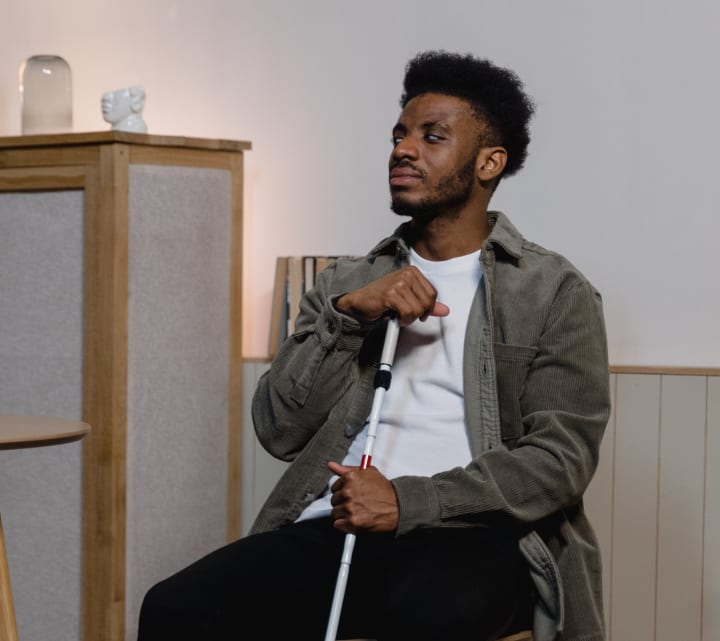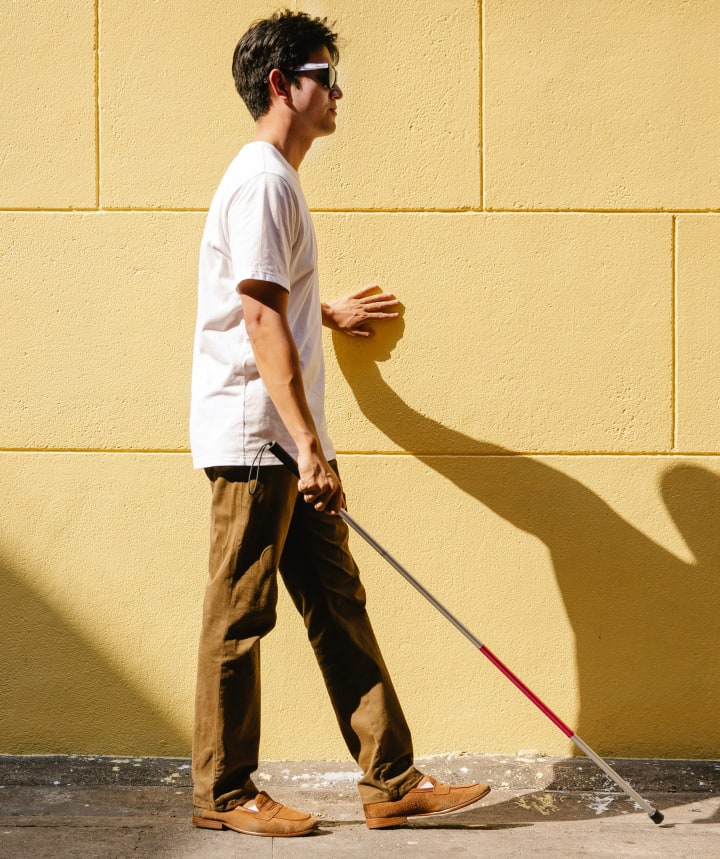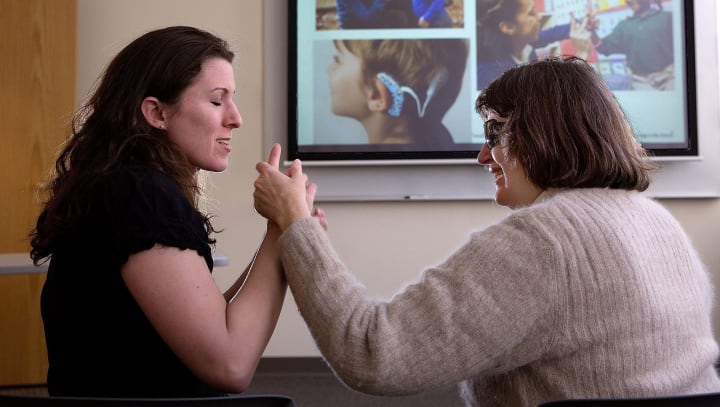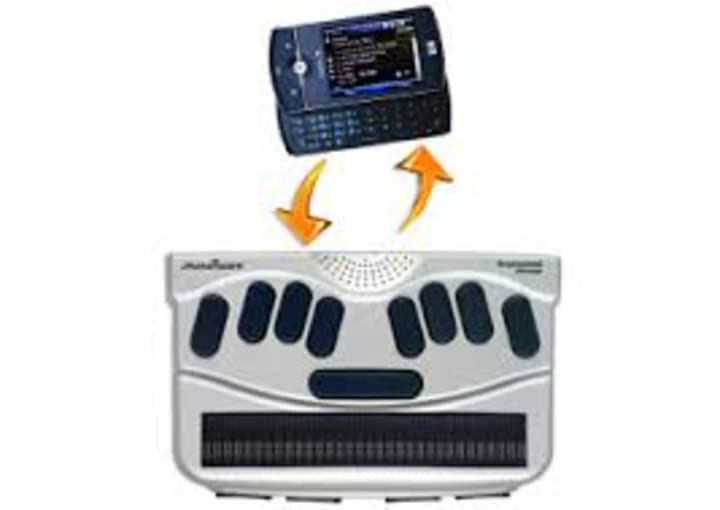No B.S.: Unveiling the Truth about DeafBlindness
The No Sugarcoating Truth about DeafBlindness to Set the Facts Straight
A while ago there was a dangerous social media rumor claiming Helen Keller was a hoax.
This then fueled the misconception that DeafBlind people cannot learn. This harmful narrative implies that DeafBlind individuals lack the capacity for intellectual development, which is demonstrably untrue.
As a DeafBlind writer, I've experienced firsthand the harmful effects of this hoax. It's time we debunked it and learned the facts.
1. Did Helen Keller Exist?
Yes, she lived from June 1880 - June 1968. She was born hearing and sighted but became sick at 19 months old and lost those senses.
She was taught by Anne Sullivan who taught her the alphabet and language. They communicated through tactile fingerspelling - spelling each word out in the hand.
Helen graduated from Radcliffe College with a Bachelor of Arts degree in 1904. She wrote 12 books and several articles.
Part of the social media gossip was that Helen wasn't blind and deaf if she flew a plane. Come on folks - she may have taken the control stick for a few minutes while the pilot watched. It doesn't mean she took off and landed the damn plane.
I'm DeafBlind and I've driven my husband's pickup truck around an abandoned parking lot a few times - it doesn't mean I have a license & I can drive myself to the grocery store now.
2. What's the Proper Terminology?
Agencies and advocates for years have labeled it deaf/blind, deaf-blind. deaf and blind, and so on.
We in the DeafBlind community in recent years are pushing for the proper spelling as DeafBlind. Just like the Deaf community capitalizes the D in Deaf to represent Culture and sameness, we DeafBlind are a unique culture within a Culture. We are Deaf, we are Blind - DeafBlind.

3. Are They Completely DeafBlind?
No, this is only true for a small percentage - about 6% are completely DeafBlind.
Most of us have some usable vision or usable hearing. How much they can see or hear differs among individuals.
In my case, my vision is about 20/200 without glasses and 20/100 with glasses, that's the strongest they could get. See - glasses aren't a cure for everyone. I've had 2 cataract surgeries which improved my vision from my original 20/400 sight. In addition to the bad vision, I have nearly no peripheral vision, and I have other vision issues like Nystigmatus, "Visual Snow", Floaters, Glare sensitivity, Night blindness....should I stop now?
I've worn hearing aids since I was 2 years old until I couldn't hear my name called across the dinner table at 35. I decided on a cochlear implant which improved my hearing to a mild level loss, but speech comprehension is about 30%. Therefore, CIs are not a cure for deafness.
4. Were They Born DeafBlind?
No not many, statistics are hard to pinpoint because of varying definitions, but estimations range between 1 in 10,000 to 1 in 20,000 births are DeafBlind.
Many things can cause DeafBlindness, here's a few:
- Usher Syndrome: 3 types of Usher Syndrome that cause people to be either born with hearing loss and lose their vision later in life, or vice versa.
- Congenital Rubella Syndrome (CRS): If a pregnant woman contracts rubella (German measles), it can cause the baby to be born with both deafness and blindness.
- Meningitis: Severe cases of bacterial or viral meningitis can lead to hearing loss and vision loss.
- CHARGE Syndrome: A genetic condition that can affect many areas of the body.
- Prematurity: Premature birth and associated complications can sometimes lead to deafblindness.
- Acquired Causes: Certain illnesses, injuries, or environmental factors can contribute to acquired deafblindness. This includes conditions such as neurodegenerative disorders, traumatic brain injury, and exposure to certain medications or toxins.

5. How Many People Are DeafBlind?
Again, numbers are influenced by the varying definitions of what is deafblindness. Estimates indicate that there are approximately 70,000 - 100,000 people in the United States who are DeafBlind.
Sure, you've seen us, we're everywhere! But you probably just thought we were regular people living our regular lives - since we don't wear signs around our necks identifying us as DeafBlind.
6. What's It Like Being DeafBlind?
Asking ten DeafBlind individuals will reveal a variety of perspectives, colored by their unique experiences with deafness and blindness. Age of onset, acceptance, cultural background, and access to resources all play a significant role in shaping their individual views.
Beyond their individual experiences, factors like parents' involvement, educational opportunities, and access to assistive technology further influence DeafBlind individuals' views. Connections within the DeafBlind community also play a crucial role in shaping their perspectives.
For a basic feel of being "deafblind", check out this vision loss simulator and this hearing loss simulator for varying types of vision and hearing loss.
Please note that strapping on a bandana or wearing earplugs and pretending to be 'Blind for a day' or 'Deaf for a day' can be misleading and won't capture the true nuances of these sensory experiences.
I've seen YouTube videos of individuals trying this and I cringe. I watched one video of a woman who donned a bandana and struggled to walk through a parking lot and into a store - arms flailing in every direction while the videographer shouted directions. Please tell me have you seen a Blind person do this in real life? We have tools for independence and can get around just fine.

7. What Can DeafBlind People Do?
The same as you - just slower and differently. We have different tools and technology to access the world around us.
But what can we do for a living? Many things!
- Computer Programmers
- Data Analysis and Research
- Freelance writers and Braille Proofreaders
- Teachers and Teaching Assistants
- Vocational Rehabilitation Counselors and Trainers
- Online Customer Service & Technical Support
- Volunteer for a variety of agencies and causes
- Anything they can do with the training and the proper accessibility tools - It's usually the Public's bias stopping them.
I'm an online ASL Teacher, Freelance Writer, Course Creator, Wife, and Mom of two young adults. Many people have told my husband it's wonderful that he's taking care of me. No, I'm the caretaker.
8. How Do DeafBlind People Get Around?
On a throne carried by 4 eunuchs?
It all depends on how much vision they have and personal preference.
They can range from:
- No tools: can see well enough to get around without aid
- White Cane: use a white cane to get around in public (not necessarily around their own home though)
- Guide Dog: they use a guide dog
- Sighted Guide: a sighted guide leads them. This can be an untrained family member or friend, or a trained assistant called a Support Service Provider (SSP) or Co-Navigator. These are not caretakers, they provide visual and audio information to the DeafBlind person who makes their own decisions based on this information.
- Accessible tools for Smartphones: They can get around using their smartphone and a refreshable braille screen reader. There's also a wearable GPS device that sends haptic signals for GPS direction.
Here's a quick video showing a DeafBlind man commuting to work:
9. What Accessibility Tools Do They Use?
Accessibility tools have advanced so much recently, with innovations like the haptic GPS I mentioned and a smart white cane. These advancements are opening up new possibilities for DeafBlind people.
Which ones can DeafBlind people use? It depends on their degree of vision or hearing loss. Some can use:
- VoiceOver (spoken text of computer screen or phone screen) if they have usable hearing
- Speech to Text: Types out spoken words on phone screen Life Transcribe on Android for example
- Refreshable Braille Display: Transcribes screens into refreshable braille to be read. The picture at the top is an example of one.
- Visual Alert Systems: Light flashers for alarms, door knocks, fire alarms, etc. This can be for those with usable vision. These can come with a pager-type device for haptic vibrations for the same alerts.
- Magnifiers: Magnifiers come in many forms, from handheld lenses to TV-like screens (CCTVs) that enlarge anything on the screen. Even computer software like ZoomText or JAWS can magnify your computer screen.
- Tools for Independence: There's a multitude of smaller devices for independence such as color identifier, money identifier, water level indicator, tactile bumps to put on frequently used buttons, and many more haptic tools.
Our tools and technology are extensions of ourselves, helping us navigate life our way. We're not limited, we're empowered.
Sadly, financial, familial, and informational hurdles deny some DeafBlind the life-changing power of tech and keep them from discovering the rest of the world.
There is a federal program called icanconnect that provides those who are DeafBlind with equipment to connect to the world around them and helps with communication at no cost.
10. How Do You Communicate With A DeafBlind Person?
Connecting with someone who is deafblind can seem like a challenge, but with a little understanding and flexibility, it can be a rewarding and enriching experience. Here are some helpful tips for effectively communicating:
- Get their attention first
- Introduce yourself every time. It doesn't matter if they've known you for years, always introduce yourself.
- Ask them their preferred method of communication and use it.
- Use their device - they may pass you a smartphone to read their messages they type on their braille device and you can type back on the qwerty keyboard.
- Some do ask you to speak - speak clearly and somewhat slowly.
- Print in palm - write out words in capital letters into their palm.
- Write - write big and clearly on their notepad
- Gesture - if they're asking directions, point and wait until they see where you're pointing. Shake your head yes or no clearly.

11. What Etiquette Should I Remember?
Understanding the unique experiences of DeafBlind individuals is key to interacting with them in a respectful and inclusive way.
Here are some important etiquette guidelines to remember:
- Be patient and allow time for responses: Processing information and communicating may take longer.
- Do not play the "Guess Who I Am" game or cover their eyes, this is just rude and can be triggering for some. I might whack you with my cane if you try.
- Do not ask if we want to feel your face so we know what you look like. Eww, no!
- Respect personal space, do not grab us or touch our possessions. Do not grab our canes or pet our Guide Dogs.
- Offer assistance but don't get offended if we turn you down. Don't you think if we got there on our own, we can leave on our own?
- Treat them with the same respect and dignity you would anyone else! Remember, they are individuals with unique experiences and perspectives, just like everyone else.
Read my other article on the 10 things to know about DeafBlindness for more ideas.
12. How can I Help?
I've discussed about the DeafBlind community, the challenges and triumphs of communication and etiquette tips.
Now, let's turn knowledge into action! Here are some ways you can be an advocate for positive change:
- Spread awareness: Share information about DeafBlindness and accessibility to your friends, family, and community.
- Challenge misconceptions: Speak up against prejudice or negative stereotypes towards the DeafBlind community.
- Support accessibility initiatives: Advocate for better access to resources, technology, and communication supports for DeafBlind individuals.
- Volunteer: Volunteer at fundraisers, agencies, and events.
- Become a SSP: Train to become a Support Service Provider to drive and guide DeafBlind individuals in your area. (Some states do not have an SSP program, you can lobby for one)
Remember, your actions, big or small, can make a difference. Together, we can create a world where DeafBlind individuals can thrive and fully participate in all aspects of life.
Take the first step today! Share this information, advocate for awareness, and embrace inclusivity in your interactions.
About the Creator
Tracy Stine
Freelance Writer. ASL Teacher. Disability Advocate. Deafblind. Snarky.
Enjoyed the story? Support the Creator.
Subscribe for free to receive all their stories in your feed. You could also pledge your support or give them a one-off tip, letting them know you appreciate their work.







Comments
There are no comments for this story
Be the first to respond and start the conversation.